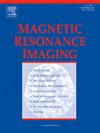Efficient 3D FISP-MRF at 0.55 T using long spiral readouts and concomitant field effect mitigation
IF 2.1
4区 医学
Q2 RADIOLOGY, NUCLEAR MEDICINE & MEDICAL IMAGING
引用次数: 0
Abstract
Purpose
To demonstrate the feasibility of SNR-efficient 3D fast imaging with steady state precession MR fingerprinting (FISP-MRF) using long spiral readouts with mitigation of concomitant field effects at 0.55 T.
Methods
Fourteen FISP-MRF sequences with different spiral readout lengths (2.9 ms to 22.0 ms) were implemented with the open-source Pulseq framework. Datasets were reconstructed using a low-rank and subspace model-based reconstruction combined with MaxGIRF spatial encoding model. Concomitant field-induced blurring and MRF precision were evaluated using reconstructed images and quantitative maps acquired from an ACR phantom, an ISMRM/NIST system phantom, and 2 healthy volunteers.
Results
A simulation study shows that the SNR of time-series images would increase by ∼2× in white matter as a spiral readout increased from 2.9 ms to 22.0 ms. Empirically, MRF T1 and T2 standard deviations of in-vivo white matter were reduced by ∼50 %, and concomitant field mitigation was necessary. Residual spatial blurring was non-negligible for readouts ≥16.5 ms, suggesting an operating regime (2.9–16.5 ms) for 3D FISP-MRF at 0.55 T.
Conclusion
We demonstrate SNR-efficient 3D FISP-MRF using long spiral readouts in conjunction with concomitant field-induced blurring mitigation. A wide operating regime with improved precision is feasible only after concomitant field mitigation.
有效的3D FISP-MRF在0.55 T使用长螺旋读数和伴随的场效应缓解。
目的:证明稳定状态进动磁共振指纹识别(FISP-MRF)的高信噪比3D快速成像的可行性,该技术使用长螺旋读数,并在0.55 T时降低伴随的场效应。方法:采用开源Pulseq框架,对螺旋读出长度(2.9 ms ~ 22.0 ms)不同的14个FISP-MRF序列进行测序。采用基于低秩子空间模型的重构方法结合MaxGIRF空间编码模型对数据集进行重构。利用ACR假体、ISMRM/NIST系统假体和2名健康志愿者获得的重建图像和定量图,评估伴随的场致模糊和磁共振成像精度。结果:仿真研究表明,当螺旋读数从2.9 ms增加到22.0 ms时,时间序列图像在白质中的信噪比提高了约2倍。根据经验,体内白质的MRF T1和T2标准差降低了~50 %,并且需要伴随的现场缓解。当读数≥16.5 ms时,剩余的空间模糊是不可忽略的,这表明3D FISP-MRF的工作范围(2.9-16.5 ms)为0.55 T。结论:我们展示了使用长螺旋读数结合伴随的场诱导模糊缓解信噪比高效的3D FISP-MRF。只有在伴随的现场缓解之后,才能实现提高精度的大范围操作制度。
本文章由计算机程序翻译,如有差异,请以英文原文为准。
求助全文
约1分钟内获得全文
求助全文
来源期刊

Magnetic resonance imaging
医学-核医学
CiteScore
4.70
自引率
4.00%
发文量
194
审稿时长
83 days
期刊介绍:
Magnetic Resonance Imaging (MRI) is the first international multidisciplinary journal encompassing physical, life, and clinical science investigations as they relate to the development and use of magnetic resonance imaging. MRI is dedicated to both basic research, technological innovation and applications, providing a single forum for communication among radiologists, physicists, chemists, biochemists, biologists, engineers, internists, pathologists, physiologists, computer scientists, and mathematicians.
 求助内容:
求助内容: 应助结果提醒方式:
应助结果提醒方式:


